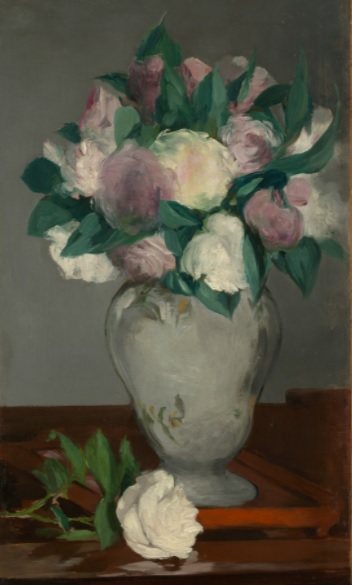
Édouard Manet
French, 1832–1883
Peonies, 1864-65
oil on canvas
23 3/8 x 13 7/8 in.
Metropolitan Museum of Art, New York, Bequest of Joan Whitney Payson

Henri Fantin-Latour – Portrait of Édouard Manet, 1867
“I can’t share the conclusions that Zola draws, as if Manet were a man who’s opening up a new future for modern ideas in art, as it were; to me Millet, not Manet, is that essential modern painter who opened the horizon to many.”
– Letter to Theo, 3 February, 1884
COMMENTS
You’ll see Van Gogh’s works and the works that inspired him. One example, in particular, is Édouard Manet’s “Peonies” (1864-65), which in many ways resembles “Roses” (1890), a still life Van Gogh painted with such heavy impasto that, according to one of the artist’s letters, it would take an entire month for the paint to dry.
Van Gogh’s and Manet’s still lifes will be the highlights of a section of the exhibition that also includes a flower painting by Henri Fantin-Latour and still lifes by Jean-Seméon Chardin and Emile Bernard.
Elsewhere in the installation, visitors can view Van Gogh’s “Vase with Poppies” (1886). Digital X-ray analysis of the latter still life has revealed what appears to be a self-portrait of the artist hidden beneath the surface layer of paint.
https://www.nbc4i.com/news/local-news/columbus/through-the-eyes-of-an-artist-vincent-van-gogh/
This picture belongs to a series of peonies that Manet painted in 1864–65. Reportedly his favorite flower, Manet grew peonies in his garden at Gennevilliers. Their broad petals and leaves and their delicate hues were perfect vehicles for his loose and sensuous brushwork and for his virtuosic handling of subtle harmonies of color.
https://www.metmuseum.org/art/collection/search/436961
How interested Manet was in the metaphysics of Dutch still lifes is a matter of speculation. But he cannot have been unaware of the similarity between the newly enriched society of seventeenth-century Dutch burghers and nineteenth-century French bourgeois, both groups being self-made capitalists. … Manet’s flower of choice in his vanitas still lifes is the peony. Manet cultivated peonies, his favorite flower along with the white lilac, in the garden of the family property at Gennevilliers. The new affluence of the French middle class created a market for smaller, more intimate paintings than the somber “grandes machines” of historical scenes; flower still lifes were much in demand. Cut flowers for the more affluent had become a booming business. Demimondaines were especially noted for their extravagant purchases in flower shops, as were the “Arthurs” who courted their favors. Even among more conservative clients, an entire culture of flower symbolism was fashionable at the time, making a bouquet as eloquent as a love letter or a poem.
All or some of these factors may have entered into Manet’s production of seven peony still lifes in 1864, each demonstrating technical brilliance and ravishing beauty. But the impulse to paint still lifes just then may have sprung from his mood at the time. Depressed over the general hostility of critics and public to his works, he may have been loath to undertake another controversial subject. Even his skill as a painter was being questioned repeatedly. Flower paintings could show the most intractable critics how capable he really was, and also attract potential buyers.
Beyond these factors, it would be a mistake to overlook the emotional intensity of these paintings, especially if compared with the flower still lifes of other notable exponents of the genre, such as the earlier Flemish and Dutch painters. Their botanically accurate paintings may have conveyed a political symbolism or, in the case of tulips, have served as the only available samples for a wild futures market, but they do not have the emotional impact of Manet’s canvases. In eighteenth-century France, Elisabeth Vigée-Lebrun produced opulent flower arrangements for her aristocratic clientele, and among Manet’s contemporaries Fantin-Latour created undisputed masterworks in the genre. Their sumptuous bouquets are not infused with the melancholy and sensuality of Manet’s peonies, or with the note of evanescence that recalls the classic theme of “vanitas” — loss, emptiness, withering.
In each of Manet’s peony paintings, we see cut flowers lying on a table while others stand in a vase. In some of them we even see the shears used to cut them. In the most elaborate, Vase of Peonies on a Pedestal, one writer has seen an allegory of the death of the flower, from the buds on the upper right, the opening blooms on the left, and the full — blown flowers in the center to the dropped petals on the lower left. A personal allegory can be read into this as well: the budding painter, cut down by insensitive critics, left to wither without achieving the fullfillment of his talent or the recognition of his achievement. “Vanitas”, true, but the painting remains.
- Beth Archer Brombert, Edouard Manet: Rebel in a Frock Coat, Boston: Little White, 1996, 165-166
SBMA CURATORIAL LABELS
This floral still life of peonies is likely very similar to one that we know Van Gogh saw with Theo at the auction sale of John Saulnier’s collection on June 5, 1886. As he recollected for Theo in a letter from August 23 or 24, 1888: “Do you remember that one day at the Hotel Drouot we saw a quite extraordinary Manet, some large pink peonies and their green leaves on a light background? As much in harmony and as much a flower as anything you like, and yet painted in solid, thick impasto and not like Jeannin. That’s what I’d call simplicity of technique. And I must tell you that these days I’m making a great effort to find a way of using the brush without stippling or anything else, nothing but a varied brushstroke. But you’ll see, one day.”
In the history of art, Manet may be one of the few artists to rival Van Gogh in the modern reinvention of the traditional vanitas subject of the floral bouquet. The transitory beauty of the blooms at their peak contains within them the melancholy eventuality of their decay, forever fixed and echoed in the belatedness of paint.
- Through Vincent's Eyes, 2022
